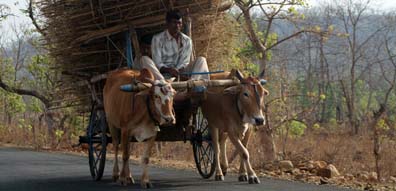India is playing an ever-important role in the world’s cotton market. Set to bypass the United States and become the world’s second largest producer of cotton in 2007, India has seen its cotton sector undergo critical changes in recent years. This handbook explores the various facets of cotton production in India — from the introduction of biotechnologies and the subsequent increase in production to the despair of small-scale cotton farmers — and analyzes the domestic and international forces at play. Cotton subsidies and agricultural policy are closely examined.
A Growing Rural Trend
Suicides among Indian farmers have been on the rise for the past decade. The government estimates 25,000 farmers have committed suicide since 1997. Cotton farmers have been hit the hardest, but spice, potato and onion growers among others have also been touched by the phenomenon. Most suicides have occurred in Andhra Pradesh, Maharashtra, Karnataka, and Kerala. Many farmer suicides are carried out by the ingestion of easily available farm products like pesticide. The states of Andhra Pradesh and Maharashtra have experienced the highest number of cotton farmer suicides. According to the Federation of Andhra Pradesh Farmers Associations, the numbers of suicides always rise from April to June because it is the time of the year when farmers find out whether their crop has failed and when money lenders come to collect their payments. In the eastern part of Maharashtra lies a region called Vidarbha, which is frequently referred to as India’s ‘cotton belt.’ Cotton farmer suicides in Vidarbha have been meticulously recorded by activist Kishor Tiwari (featured in The Dying Fields). In the first six months of 2007, Tiwari counted over 500 cotton farmer suicides, or an average of three suicides a day.
Roots of the Crisis
Although cotton production has steadily increased over the past few years, a fall in profitability has led many cotton farmers to commit suicide. The following are among the factors most often cited by specialists who have studied the issue.
– Input costs such as seeds, fertilizers and pesticides have risen substantially while world cotton prices have steadily declined. In 1994, a pound of raw cotton fetched $1.10. In 2006, the same pound fetched 54 cents. Today, most Indian cotton farmers cannot make ends meet.
– Farmers in Maharashtra, specifically, have also had to cope with the removal of a government safety net that guaranteed them fixed cotton prices. Starting in the 1970s, the state of Maharashtra would purchase all cotton production at a price independent of world market prices. This program was called the Monopoly Cotton Procurement scheme. This program guaranteed cotton farmers a fixed price for their entire crop. Mismanagement and financial losses led the state to open up cotton trade to private traders in 2003 and to discontinue the monopoly scheme. The state still purchases some raw cotton from farmers, but the average prices it offers are below the average cost of production.
– Government support has declined. The extension centers run by the local government have not been able to provide farmers with adequate information and training regarding growing the new varieties of cotton. To choose seeds, many farmers rely on information given by private seed companies.
– Access to formal credit has become more difficult. The Indian rural credit system has faced a financial crunch that has led state banks to tighten their lending requirements. Many farmers have to resort to informal sources of credit. Farmers borrow funds from moneylenders, friends and relatives. Moneylenders tend to charge usurious rates and have draconian collection tactics that can lead farmers to despair.
– The many farmers who lack irrigation have to rely on monsoon rainfalls to water their fields. Two out of the last five monsoons provided insufficient levels of water for productive cotton cultivation.
– Years of heavy usage of chemical fertilizers have exhausted the soil. Most cotton farmers do not rotate crops nor leave enough time for the soil to naturally replenish. Instead, farmers hope additional fertilizer will improve the quality of their soil.
Government Response
The government of Maharashtra and the government of India have tried to resolve the suicide crisis through programs aiming at improving access to formal sources of credit and irrigation. Among the various programs:
– The government of Maharashtra set up a fund to help farmer widows, called the Chief Minister’s Relief Fund. A widow who qualifies for compensation will typically receive the equivalent of $2,500. Government compensation is contingent on three things: the deceased had to have officially owned the land worked, the deceased was indebted when the suicide occurred, and debt was the cause of suicide. The government has denied payment to many widows on the grounds that the farmer’s land was in the father or spouse’s name, there was no clear evidence to attribute the suicide to crop failure, or that the farmer was still receiving loans despite the fact that he may been in default with another lender. Even widows eligible for the $2,500 compensation only receive about one-third of the full amount. The rest is placed in a fixed deposit.
– In 2006, the Indian government unveiled a $930 million relief package to assist cotton farmers in eastern Maharashtra. The relief package included irrigation projects and debt relief. A year after the announcement, state officials complained to India’s agricultural minister about the slow progress made by nationalized banks to reschedule farm loans and reduce the interest rate charged to farmers. Also no progress was reported on watershed development, rainwater harvesting, and micro-irrigation projects. The effective implementation of the relief package suffers from cumbersome guidelines and confusion regarding the availability of funds.
Sources: NPR; BBC News; Frontline World; The Economist; The Hindu; Z Magazine
- Previous: Bt Cotton Farming
- Next: Agriculture in India



